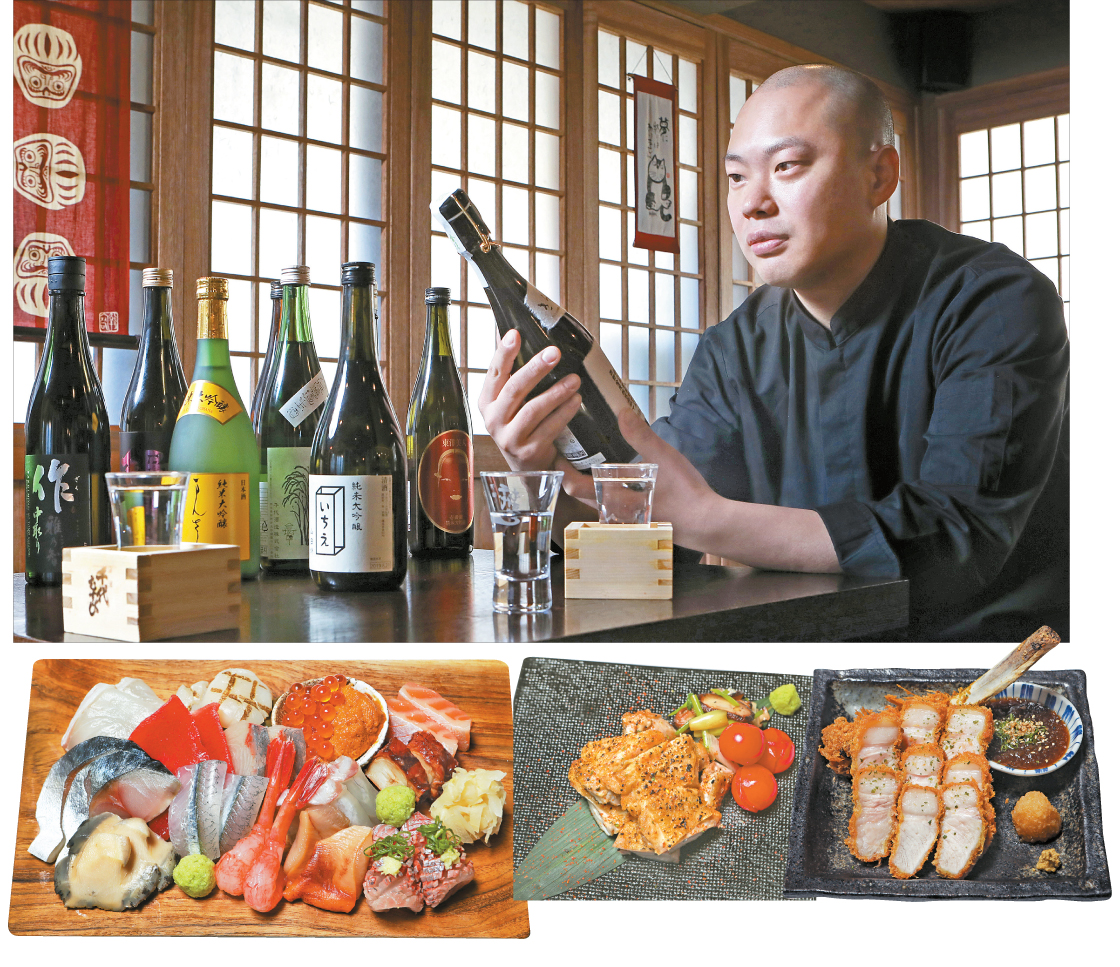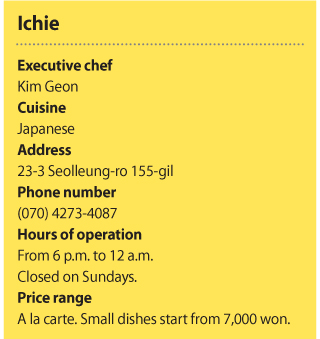Comfort food proves to be a hit after work: After perfecting simple izakaya dishes, Kim Geon is ready for more

Chef Kim Geon, top, runs the casual Japanese izakaya Ichie, which has one of the largest lists of Japanese sakes in Seoul. It offers many of the dishes, left and above, that people are familiar with so that they can feel comfortable eating food paired with their drinks. [PARK SANG-MOON]
The scene chef Kim Geon wanted to create was something one could find in a neighborhood bar in the Japanese countryside. The interior is all wood without too many decorative items, creating a classic yet aged look. The plating of food is also very straightforward without too many garnishes on top.
The familiar ambience and the comfort food quickly attracted a loyal group of fans, especially men in their 40s and older, which is quite different from the crowd often seen at restaurants in Apgujeong-dong and Cheongdam-dong in southern Seoul, where women of all ages often meet to share meals.
“The young generation seems to be thirsty for something new and trendy,” said Kim, explaining the reason why his restaurant has a very different demographic. “People who want drinks and some food to fill up their stomachs come after work, and that’s what exactly I wanted to have at my restaurant.”

Even now, his food stays true to its taste. Since puffer fish is in season right now, there are many ways Kim is serving it, whether fried or grilled on charcoal. He served all the basic and classic dishes like yakisoba, which is surprisingly difficult to find at many of the newly-opened Japanese casual restaurants and bars in Seoul.
“We don’t do a complicated cooking process,” said Kim. “Appealing to the basic instinct and appetite of the consumers is the key.”
His take on Japanese food comes from the street. He was given tuition to register at a cooking school in Tokyo in 2005 after he was discharged from his military duty, yet he never did so. Instead, he spent all of his money on eating food at restaurants he couldn’t afford to go to before. He traveled everywhere in Japan, experiencing how each region’s cuisine is different in person and trying the new trends popping up in each region.
“The best thing I have done in my life was using all that money on eating,” said Kim. “Everything was so exciting.”
Then he came back to Korea to open his first restaurant in Yeonnam-dong in Mapo District, western Seoul. He never learned from a chef that he could call a teacher. More than half of his cooking skills and knowledge come from studying by himself while running his own restaurants. All the photos he took while eating at restaurants around the world become a valuable asset to look back on when looking for references or ideas.
After years of making simple dishes, his desire to explore a more extensive world of cooking comes out in his newer restaurant Goryori Ken, which opened in 2017. When it first opened, he presented more expensive and rare ingredients in a course menu, which is popular at many of the upscale Japanese restaurants in Japan. However, delving more into the world of Japanese cuisine made him curious about mixing and matching what he knows about Japanese cooking with something Western. He closed and then reopened Goryori Ken a few months ago to try out the new concept.
“There are many restaurants that focus more on what ingredients they present, but I felt that I would face a wall soon in Seoul because the supply of rare ingredients is only so much,” he said, adding that doing the same thing over and over again might tire himself as well as guests.
What he does now is taking seasonal ingredients he is familiar with in Japanese-style cooking, adding Western-style sauces or spices, and completing them with garnishes that help make the dish look Japanese while the taste is more Western.
He is also planning to do more collaborations with chefs specialized in other cuisines, including Korean, to see how versatile his food can become.
“You only see as much as you know,” said Kim. “If I feel like my view is limited, I go for more experiences and try to expand my ideas to see the direction I want to go in.”
BY LEE SUN-MIN [summerlee@joongang.co.kr]










with the Korea JoongAng Daily
To write comments, please log in to one of the accounts.
Standards Board Policy (0/250자)